
|
|
| Rock is another natural and essential element for
the construction of a Japanese garden. |
Rocks of all sizes are used in many ways.
Functional as bridges. As a construction material, shoring pond embankments,
creating waterfalls, stream beds and defining paths. Unique shapes
are prized and may be artistically used to represent objects or mythical
landscapes. |
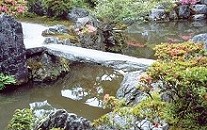
Ginkaku-ji Kyoto |
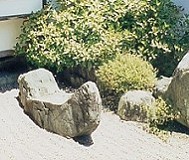 |
|
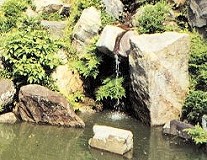 |
|
'Treasure boat' rock - Daisen-in
|
Tobi-ishi
(stepping stones) - Korakuen
|
Chishaku-in
Kyoto |
| But most are laid for
their quality as design elements to give; direction, focus, balance,
harmony, contrast and texture. Placing rocks is a an art, which is
displayed in all of Japan's gardens. |
The most unique style of Japanese gardens is undoubtedly
the Zen rock garden.
Kare-sansui 'Withered mountain water',
are small scale, dry landscape spaces.
They were introduced toward the end of the 14th century. |
Kyoto is the place to see the finest examples
of this style. Including the most well known and acclaimed rock garden,
Ryoan-ji. Strongly influenced by early
Chinese ink paintings, the style sought to represent a monochrome
landscape.
Often enigmatic, encouraging meditation and contemplative maintenance,
they are Zen art.
|
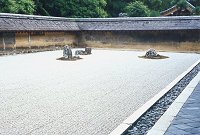
Ryoan-ji Kyoto |
Kare-sansui
style, though well suited for your own design, does raise a problem
or two. Obtaining a gravel that looks right, is probably the main
one.
The Japanese material is a decomposed granite, called masago,
which although appearing white in it's mass, has flecks of black and
brown.
The size is between 2 and 5 mm. |
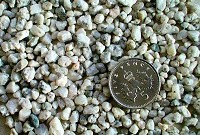
This is the real thing |
 |
Once an alternative has been
found, prepare the area with a well compressed layer of hard-core
then a sheet of landscaping fabric to help prevent the weeds.
|
| My attempt uses fine limestone
chippings. The rocks are Irish waterstone, well suited with their
cracks and weathered appearance. |
| The patterns that are
raked in the gravel often evoke the ripples in water. Other treatments
can be simply decorative with swirls and geometric designs. Just be
creative. |
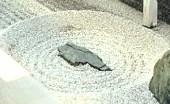 Ryogen-in Kyoto
Ryogen-in Kyoto
|
|


